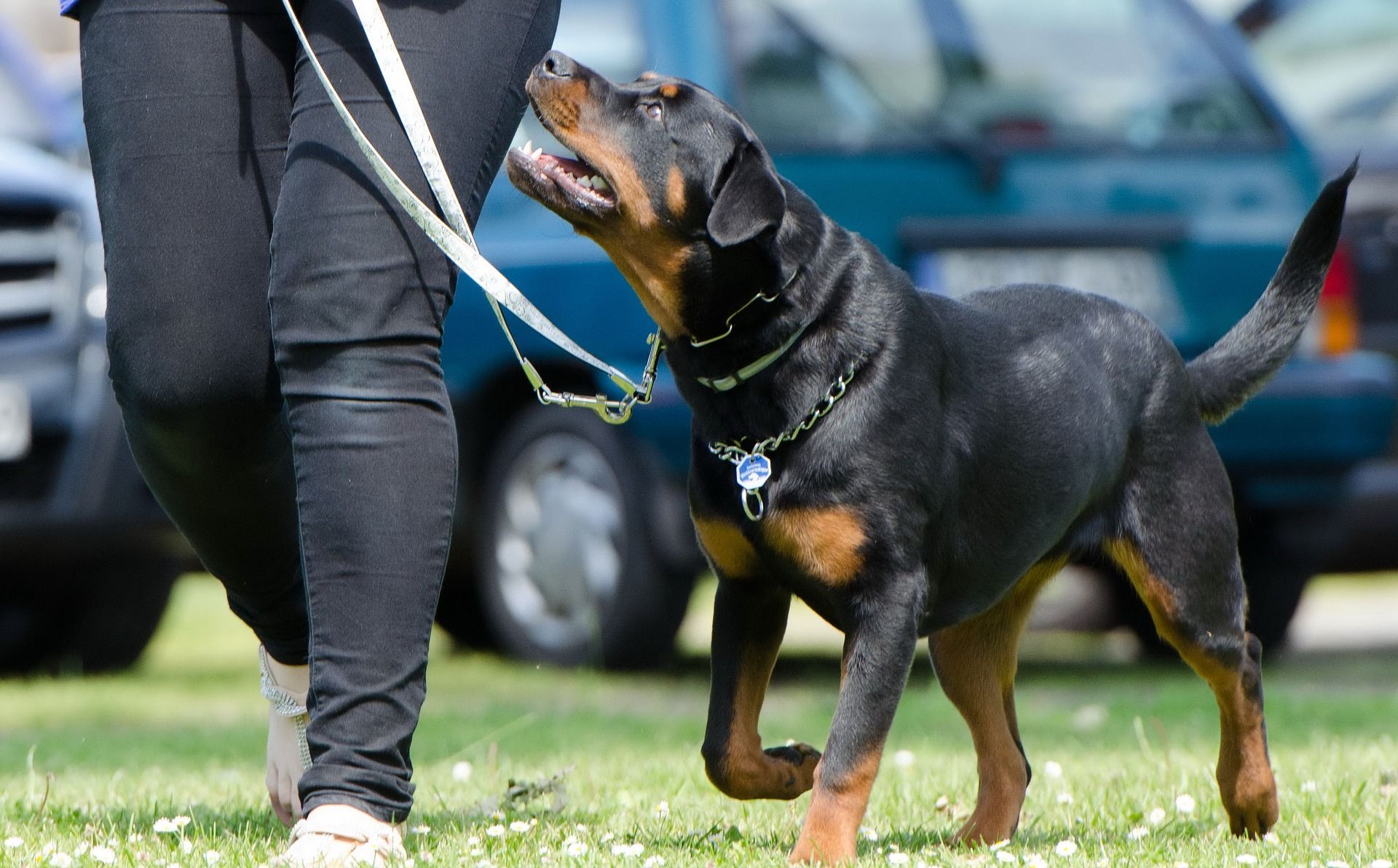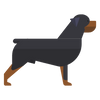Training a Rottweiler to Walk on a Leash: Step-by-Step

Rottweilers are large powerful dogs that can easily pull you along on your daily walk. In fact, pulling carts was one of the original roles of the Rottweiler. Training your Rottweiler to walk correctly on a leash is therefore very important to prevent injuries, establish your dominance and enjoy your walks together.
To train a Rottweiler to walk on a leash, first introduce them to the leash using treats as a distraction. Reward your Rottweiler for sitting still when fitting the leash. As you walk, stop whenever your Rottweiler pulls and command them to 'heel'. Reward them when they come, then continue walking.
I will run through this process in more detail below, following a step-by-step approach. It is important to also keep in mind common mistakes that Rottweiler owners make when leash training.
Training a Rottweiler to Walk on a Leash
There are two key steps in leash-training a Rottweiler. First, you must introduce them to the leash and harness (if using one). Then, you will need to focus on training them to walk with the leash.
Both of these concepts can be learned quickly if you are consistent with the methods below. Positive reinforcement (treats or praise) is the key to establishing good behaviour, which you will see below.
Phase 1: Introducing the Leash
Introducing the leash is a vital step in preventing your Rottweiler from biting the leash and getting overexcited when they go for a walk. You can also do the same for a dog harness, which I recommend when leash-training your Rottweiler. Below are steps you can take to do this effectively.
- Hold out a treat in one hand so your Rottweiler can see
- Once you have their attention, hold out the leash in the other hand
- After a few seconds of remaining calm (you may have to wait), reward your Rottweiler
- Hold out another treat
- Put the harness or leash on while holding the treat
- One the harness and/or leash is on, reward your Rottweiler
The trick here is that you are diverting your Rottweiler's attention while introducing and fitting their leash and harness. Make sure you only give a treat when they have been calm for a few seconds. They will soon learn that remaining calm while putting on a harness and leash is good behaviour.
Phase 2: Walking on the Leash
Walking on a leash will introduce your Rottweiler to the concept that you are the alpha and they must follow you. This will help earn respect with your Rottweiler, and is best done at an early age.
- Secure the harness and leash to your Rottweiler
- Hold a fistful of treats in your hand, at waist-level
- Start walking
- When your Rottweiler pulls (whether pulling forwards or refusing to walk), stop walking
- Command your Rottweiler to 'come' or 'heel' (firmly, but only once)
- Wait for them to come to your side
- When they (eventually) come, give them praise and a treat
- Continue walking
You can start walking your Rottweiler inside to get them used to the idea of being led around. These walks can be less than 5 minutes long.
Once they get used to walking by your side indoors, introduce them to walking outside. Again, start with short walks and build up to longer ones. There will be far more distractions and temptations outside, so be prepared for a regression in behaviour when you move outdoors.
Common Mistakes in Leash Training
When training your Rottweiler, keep these common mistakes in mind. It is easy to fall into bad habits (everyone does), but just remember that they will make your life much harder when your Rottie is big.
Pulling Back on the Leash
Your Rottweiler will either pull you forward, or refuse to move. Both of these actions are considered pulling on the leash. In this situation, make sure you do not pull on the leash yourself, otherwise you will engage in a game of tug-of-war.
This will encourage your Rottweiler to resist you and your could strain your arm. Instead, remember to firmly command your Rottweiler to 'come' or 'heel' and wait patiently for them to do so.
You should only have to say the command once. Saying too many words may confuse your Rottie. With your patience and refusal to move, you are demanding that they do as they told and stay by your side. If they refuse to move, you can use treats as an incentive.
Reinforcing Bad Behaviour
More often than not, a Rottweiler will pull on the leash because they want to go somewhere or sniff something. Allowing them to reach their goal will reinforce this bad behaviour.
You almost need to adopt a stubborn attitude to teach your Rottweiler that they can't have what they want. This can even be to the point of walking in the opposite direction if they pull you one way.
Buying a Leash that is Too Long
You need to have some laxity in your leash so that your Rottweiler can feel free when they walk by your side. Having it too short will be uncomfortable and restrictive.
However, some owners give their dogs too much freedom, allowing them to walk in front. This tells your Rottweiler that they are the leader of the walk and that you need to follow wherever they go.
Encouraging Overexcitement
Once your Rottweiler associates the leash with going for a walk, they may get excited when you pull it out. I have seen many dog owners encourage their dog to jump, bark and run around at the sight of the lead. They think that they are making their dog happier.
However, encouraging this behaviour is establishing bad habits in your Rottweiler and make it difficult to fit a harness and leash. It will also make them more likely to pull when you walk. A good Rottweiler will remain calm when you fit their harness and leash. As their humans, we should model the same behaviour.
What You Need for Leash Training
Leash training doesn't require much, but the listed items below are essential to fast and effective training.
Leash
You will need a short leash when training your Rottweiler to walk by your side. There should be a small amount of laxity so that the leash is not tight when your Rottie is by your side.
For puppies, a cheap light-weight leash is best because they will probably chew and destroy this one and the heavier leashes will be more noticeable. For bigger puppies and adults, a stronger leash is preferable. I recommend leather for its strength and durability.
Harness
Harnesses are, in my opinion, much better than attaching a leash to your Rottweiler's collar. You have more control over your Rottie and it will take the strain away from their neck. A fitted harness will also not slip off when they squirm or resist the leash.
If you would prefer to attach the leash to your Rottweiler's collar, I recommend getting one with a buckle, instead of a plastic clip. Buckles are much harder to rip open than plastic clips and therefore will not easily come undone when pulled.
Treats
As you can see, treats are used often as positive reinforcement for Rottweilers. Rotties love their food and will respond well to an edible treat. If using many treats, just keep them very small. The size of your thumb-nail is plenty. This will help prevent your Rottweiler eating too many tasty treats between meals.

